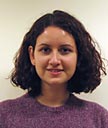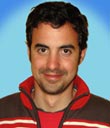|
People
|
Work Description
|
|
Andrea DAHLHOFF
|
The CERN Large Hadron Collider (LHC) is scheduled to begin operation in 2007, beginning a new era wherein the electroweak symmetry breaking of the Standard Model (SM) will be studied in great detail. Not only the Higgs Boson has to be discovered, but its potential has to be determined experimentally via the measurement of the trilinear and quartic Higgs self-couplings. Only mutiple Higgs Boson production can probe them directly. In my Ph.D. thesis I'm studying the accessibility of the SM Higgs self-couplings at LHC and at superLHC. The first time of my Ph.D. time I spent on developing the firmware of the Jet/Energy Processor, one of three units of the ATLAS Level-1 Calorimeter Trigger. |
|
Giovanna DAVATZ
|
In my PhD thesis I work on CMS, one of the four detectors to be built for the LHC p-p collider at CERN. One part of my work so far has been to involve higher order QCD corrections for signal and background in the channel H->WW->lvlv in order to get a more realistic signal over background ratio. Depending on the cuts, effective K-factors had to be found as a function of the transverse momentum. At the moment I am developping a calibration method using Pi0's for the electromagnetic calorimeter ECAL in CMS. |
|
Bilge DEMIRKOZ
|
I have been working on the AMS (Alpha Magnetic Spectrometer) experiment for the past four years. AMS is a particle physics experiment that will be installed on the International Space Station. I have been working on the AMS TRD (Transition Radiation Detector). I have measured the X-ray absorption properties of the detector materials which is important in understanding the positron-proton separation of the TRD. I have been working on the hardware and the control of the gas supply system which will provide the TRD with seven liters of gas daily for three years. I spent the summer of 2002 at CERN working on building the gas system prototype. |
|
Manuel DIAZ GOMEZ
|
I am doing my Ph.D thesis working on ATLAS, one of the four experiments that will be carried out using the new LHCC(large hadron collider) facility. During 2003, I focused in two different work areas: software development for the Liquid Argon ROD motherboard prototypes debugging tests, and within the HLT/DAQ community, working in various multidisciplinary tasks with the PESA (Physics and Event Selection Algorithms) group, aimed to validate different existing HLT selection algorithms. The results of the work were included in the HLT/DAQ technical design report (TDR), submitted in June 2003. As stated in the thesis plan, the Liquid Argon ROD is a key element of the DAQ architecture, and constitutes a basic interface between the Liquid Argon Calorimeter and the trigger/offline chain. I developed custom-made software tools in order to perform all the needed device-specific debugging tests. The software provided a GUI interface for the tests and was built using the official Liquid Argon online libraries. This task was accomplished in approximately three months, on a full-time basis. After that period only sporadic maintenance and support is supplied. Within the PESA group, I developed a monitoring tool for the HLT steering, which is the core software component driving the HLT software machinery. The software was implemented within the Athena framework and will evolve progressively, with the idea of actively using it in next yearís test beam data acquisition period. A lot of the time spent from May 2003 on concentrated in validation studies for the so-called e/g slice, which groups all the algorithms responsible for detection and/or selection of electromagnetic clusters. The work involved tuning the cuts applied on the different algorithm variables in the 2nd level trigger and computing the final electron selection efficiencies and output trigger rates that were included in the TDR. Furthermore, a complete e/g analysis framework software was developed, along with a graphical user interface, and made available for the whole ATLAS community. |
|
Miran DJORDJEVIC
|
I am working on the Integrated Pixel Tracker (IPT) of a vertex detector for TESLA, an international linear-collider project. The IPT, integrated with the vertex detector, will take the raw data from the sensors, do real-time track reconstruction, and store only the track features on disk. I am deeply involved in the design of the IPT and in the building of a demonstration model of the IPT, involving systems design and gate-array programming. Later on in my PhD, I intend to do simulations of TESLA and a Higgs-related analysis. |




